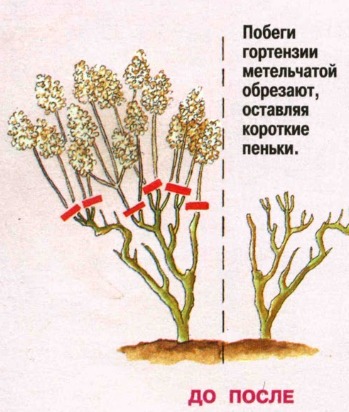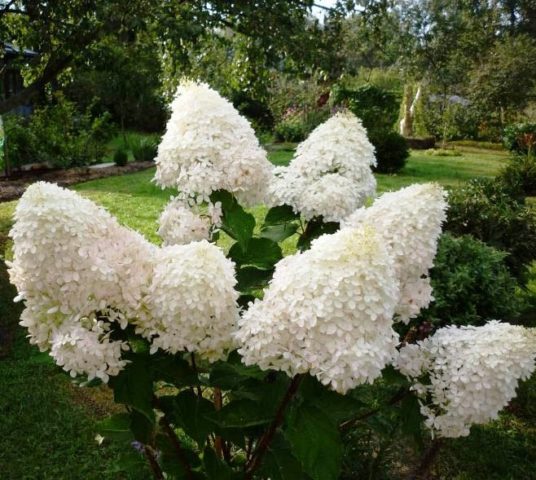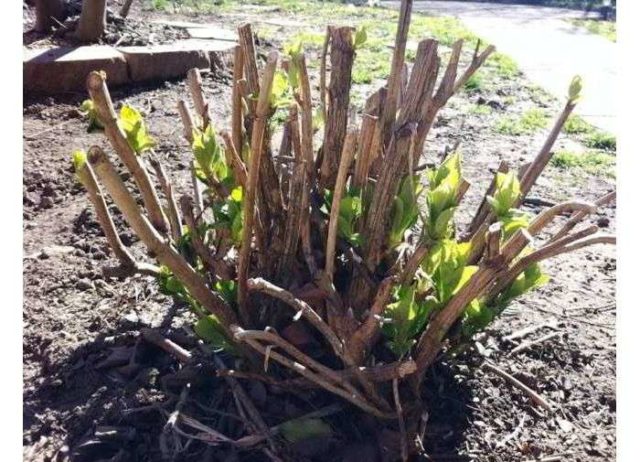Content
- 1 Do I need to prune paniculate hydrangea in the fall
- 2 Why do you need autumn pruning of panicle hydrangea
- 3 When can you prune a panicle hydrangea for the winter
- 4 How to prune a panicle hydrangea for the winter
- 5 Ways to prune hydrangeas in autumn
- 6 Care for hydrangea paniculata after autumn pruning
- 7 Experienced gardening tips
- 8 Conclusion
Pruning hydrangeas in paniculate autumn involves removing all old flower stalks, as well as rejuvenating shoots. It is better to do this about 3-4 weeks before the onset of the first frost. In order for the plant to recover well after suffering stress, it should be fed with potassium and superphosphates. In regions with frosty winters, additional shelter will need to be made.
Do I need to prune paniculate hydrangea in the fall
The panicle hydrangea needs both spring and autumn pruning. Carry out a haircut for different purposes:
- forming - remove all shoots that clearly spoil the appearance, and also thin out the crown so that it is moderately dense;
- anti-aging - removing old branches to stimulate the growth of new shoots in spring;
- sanitary - removal of broken, dry shoots, as well as branches affected by diseases and pests.
In practice, pruning of panicle hydrangea is carried out at once to solve all these problems. Moreover, old and broken off, dried up branches are removed both in autumn and spring. Otherwise, the tasks of spring and autumn haircuts are different. Often, at the end of the season, only faded panicles are cut off, and in the spring they do all the rest.
Unscheduled pruning may be necessary if the plant is damaged by strong wind or heavy rain.
Why do you need autumn pruning of panicle hydrangea
The main purpose of pruning is to remove old peduncles. Also, cutting panicle hydrangea in the fall is needed for other purposes:
- preparation for winter;
- cleaning from damaged and diseased branches;
- stimulation of active flowering for the next year.

The main purpose of pruning panicle hydrangea in the fall is to remove panicles as well as dry branches.
When can you prune a panicle hydrangea for the winter
Pruning panicle hydrangea in the fall in the first year is optional. First, the bush is allowed to take root, after which they start cutting (as a rule, starting from 3-4 years). When choosing a specific period, first of all, one should proceed from the climatic features of a particular region. The optimal time is the beginning of active leaf fall. Moreover, it is better to be in time before the first frost. Therefore, the timing of pruning in the fall can be determined as follows:
- In the middle lane and the Moscow region, this is the second half of September.
- In the North-West and the Leningrad Region, this is the first half of September.
- In southern Siberia and the Urals, haircuts start at the beginning of September. And if the month is forecast to be cold, then at the end of August.
- In the South of Russia, pruning in the fall is carried out in the first half of October.
Also, when choosing the timing of pruning, you can be guided by the lunar calendar. It is advisable to work on a clear day with relatively warm weather (at least +7 degrees).
On the one hand, it is best to finish everything 3 weeks before the onset of frost. On the other hand, you should not start work too early.In this case, new shoots can form, which will confidently grow, and then freeze slightly.
How to prune a panicle hydrangea for the winter
Pruning of panicle hydrangea in autumn is carried out according to the traditional scheme: it is necessary to remove the peduncles, that is, panicles. At the next stage (spring) pruning, all other actions are performed:
- removal of damaged shoots - both broken and dried;
- anti-aging pruning - removing all old shoots;
- pruning for lush flowering: shortening the apical shoots;
- thinning the bush to give it a beautiful shape.

Scheme of pruning hydrangea paniculata in autumn and spring
However, anti-aging pruning can be done not only in the spring but also in the fall. For this:
- significantly shorten all powerful lateral branches, leaving only 2 buds;
- only 2-3 strong branches are left on the bush (all shoots over 4 years old are cut off).
Thus, the main pruning does not take place in the fall, but in the spring. At the end of the season, it is sufficient to simply remove the dried panicles. Broken branches can also be removed if necessary (for example, shoots damaged by strong winds).

As a result of pruning hydrangea in paniculate autumn, only cut stumps remain on the bush: all peduncles are removed
Ways to prune hydrangeas in autumn
Formative plant pruning can be carried out in both spring and fall. Most often, 3 options are used to get a beautiful bush:
- Hydrangea on a trunk.
- Tall bush with a spreading crown.
- A low bush with a compact crown.
On the trunk
In the first case, it is enough to cut off all the lower shoots at a height of 50-60 cm - as soon as the bush reaches a height of at least 1-1.5 m. Most often, the formation begins from the 3rd year of the plant's life, when the hydrangea grows up and gets stronger enough. Standard pruning is done under a spherical or oval shape, which looks especially beautiful on the central shoot.
Another option is a weeping hydrangea haircut. Then the branches are pre-tilted to the ground and fixed for 1 season (from spring to autumn of the same year). A year later, the crown is thinned out at the weeping bush and weak shoots are removed.

For pruning on a stem, varieties such as Pink Diamond and Phantom are most suitable.
Spreading mouth
This is the easiest fall pruning method. Even with minimal care (watering and feeding), the panicle hydrangea grows quite well, so the crown thickens quickly due to the appearance of new shoots. On the one hand, the bush looks very beautiful, but on the other hand, the more branches, the weaker the peduncles, the smaller the flowers themselves.
Therefore, gardeners need to choose the middle ground so that the tree attracts both greenery and inflorescences. For this, it is recommended to annually shorten last year's shoots by at least 3 buds. It is optimal if the (upper) bud remaining after pruning was directed outward, and not inward of the crown.
Compact bush
In this case, the shoots are significantly shortened during pruning. As a result, 3-5 pairs of kidneys should remain. A similar haircut is carried out in the fall only in regions with a relatively warm climate (including in the middle lane). For example, in the Urals and Siberia, it is better to do it in early spring, before the start of sap flow.
It is practical to do this in small areas where there is little space.

For cutting a bush, it is most convenient to use a pruner.
Care for hydrangea paniculata after autumn pruning
Almost immediately after pruning, the panicle hydrangea must be well prepared for the winter period. First of all, it is fed with superphosphate (70 g per 1 m2) and potassium sulfate (40 g per 1 m2). These fertilizers help to increase the plant's resistance to frost and temperature extremes.
In addition, 1.5 cups (300 g) of wood ash can be scattered around the trunk circle. After that, the soil is loosened so that the fertilizer penetrates deep into the soil.Thanks to this feeding, panicle hydrangea will recover much faster from the stress associated with pruning in the fall. In addition, nutritional supplements contribute to the strengthening of the root system and the maturation of wood fibers.
Novice gardeners can use ready-made mineral fertilizers according to the instructions, for example:
- Fertika (solution);
- "Pocon" (granules that are scattered over the surface);
- kalimagnesia (1 tbsp. l. per 10 liters of moderately warm water) - watering at the root of the plant.

Thanks to proper care, even after radical pruning, the hydrangea will be able to recover next spring.
Experienced gardening tips
Experienced gardeners regularly prune panicle hydrangeas in both spring and fall. However, they recommend paying attention to some of the features of this procedure. Thanks to their advice, many beginners will be able to avoid mistakes when cutting:
- It is important to maintain sterility during pruning. The blade of a pruner or garden shears is treated with any disinfectant (for example, iron sulfate or alcohol). Slices of panicle hydrangeas must be sprinkled with crushed coal or wood ash. They can also be dipped in a solution of potassium permanganate.
- During the pruning of paniculate hydrangea in the fall, it is necessary to carefully remove the peduncles, leaving the upper 2-3 buds. It is on them that young shoots will be born. Moreover, the higher they are, the more chances that flowers will grow on them.
- Experienced gardeners do not recommend bothering with pruning a young panicle hydrangea (both in autumn and spring). However, in case of emergency, you can remove broken off branches, damaged and aching shoots.
- Despite the fact that many varieties of panicle hydrangeas are distinguished by good winter hardiness, the roots must be mulched with spruce needles and peat. It is recommended to add humus and fallen leaves. The result should be a layer 15-20 cm high. It will not only protect the roots from the cold, but also nourish the plant. Additionally, you can spud earth.
- Despite the fact that a tall hydrangea looks pretty beautiful, it is better not to leave branches higher than 150 cm. They begin to bend under the weight of the inflorescences, moreover, a strong wind can break them. Therefore, a short cut is preferred.
- In regions with a harsh unpredictable climate (Ural, Siberia), hydrangeas can be additionally covered with burlap or spandbond. This is especially important for young seedlings up to 4-5 years old.

After pruning in the fall, it is recommended not only to mulch the soil, but also to cover the panicle hydrangea for the winter.
Conclusion
Pruning hydrangeas in paniculate autumn is a mandatory procedure that is carried out starting from 3-4 years of plant life. Usually, the main events are carried out in the spring, and in the fall it is important to remove old flower stalks. But in such bushes, it is allowed to significantly shorten the shoots (rejuvenating pruning) so that the hydrangea is completely renewed in the new season.
The video will help to visually study the method of pruning panicle hydrangea in the fall for beginners:








